White Hills (Santa Barbara County) facts for kids
Quick facts for kids White Hills |
|
|---|---|
| Highest point | |
| Elevation | 233 m (764 ft) |
| Geography | |
| Country | United States |
| State | California |
| District | Santa Barbara County |
| Range coordinates | 34°36′18″N 120°26′09″W / 34.60500°N 120.43583°W |
| Topo map | USGS Lompoc Hills |
The White Hills are a low mountain range in the Transverse Ranges, in Santa Barbara County, California south of the town of Lompoc and east of Vandenberg Air Force Base.
Contents
Exploring the White Hills
The White Hills are a small, low mountain range located in Santa Barbara County, California. They are part of a larger group of mountains called the Transverse Ranges. These hills are found just south of the city of Lompoc. They are also located to the east of Vandenberg Air Force Base.
What Makes the White Hills Unique?
Unlike tall, jagged mountains, the White Hills are considered "low" mountains. Their highest point reaches about 233 meters (764 feet) above sea level. This makes them more like large hills or rolling terrain. They play an important role in the local environment.
Location and Surroundings
The White Hills are situated in a beautiful part of California. This area is known for its diverse landscapes. To the west, the Pacific Ocean influences the climate. The nearby city of Lompoc is a community with a rich history. Vandenberg Air Force Base is a significant site for space launches.
Plants and Animals of the White Hills
Even though they are low, the White Hills are home to many different plants and animals. The type of plants found here are adapted to the dry California climate. This includes various shrubs and grasses.
Local Wildlife
Many animals make their homes in the White Hills. You might find small mammals like rabbits and squirrels. Different types of birds also live in the area. These animals rely on the hills for food and shelter. The hills provide a natural habitat for them to thrive.
Geology and Formation
The White Hills are part of the Transverse Ranges. These ranges are unique because they run east-west, unlike most California mountain ranges that run north-south. This unusual direction is due to complex geological forces. Over millions of years, the Earth's crust has been pushed and folded. This process created the hills we see today.
How the Hills Were Formed
The formation of the White Hills involved slow movements of large pieces of the Earth's surface called tectonic plates. As these plates moved and collided, they caused the land to uplift. This uplift created the gentle slopes and peaks of the White Hills. The rocks in the hills tell a story of this long geological past.
Climate and Weather
The White Hills experience a Mediterranean climate. This means they have warm, dry summers and mild, wet winters. The nearby Pacific Ocean helps to moderate temperatures. This keeps the summers from getting too hot and the winters from getting too cold. Fog is also common, especially in the mornings.
Seasonal Changes
During the wet winter months, the hills become greener. Wildflowers can bloom in the spring, adding color to the landscape. In the dry summer, the vegetation often turns golden brown. This cycle of seasons supports the local ecosystem.
Importance of the White Hills
The White Hills are important for several reasons. They provide natural open space in Santa Barbara County. They also contribute to the local biodiversity. Protecting these areas helps to preserve the natural beauty and wildlife of California. They are a valuable part of the region's natural heritage.


